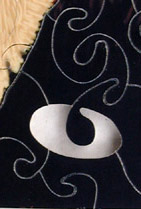The Mysterious Enigmatic Observer
I like to place figurals (for example, a puzzle piece shaped like a cat) in my puzzles. As most of my puzzles are custom puzzles, it is up to the customer to decide what figurals, if any, are to be in their puzzles. I normally get to decide where they will go, and I take care to place them in nice locations. Some figurals are designed at the customer's request and some are chosen from one or more previous puzzles I've made.
I now have a pretty good collection of figurals and the collection is growing all the time. There are quite a few I've designed myself for my "100 Puzzles Project" puzzles and early puzzles I made for which I had no orders.
I have a friend who owned a really great wiener dog named Spinoza. Eventually Wiener Dogs started to show up in my puzzles, and remind me of good times I had, with sadness. But the meaning quickly evolved, even in the first puzzle I made with a Wiener Dog, Fantasy Faire, the dog was looking at a hot dog stand! The dog symbolizes friendship and good nature, the essential spirits dogs carry within, but one must not forget that sometimes (maybe just about all the time) food is uppermost in their minds!
My favorite figural is one I call "The Observer" or usually "The Enigmatic Observer" or even "The Mysterious Enigmatic Observer". The full story of the origin has not been told, but my most reliable source indicates that the Observer's roots came from a synthesis of the East (the female side) and the West (the male side). When I started cutting puzzles, I had absolutely no idea that in two years I 'd be cutting all kinds of interesting things - a vast complex synthesis of requests from the public and my own artistic and intellectual personality have led to the spawning of so many things! The Observer first appeared in the same puzzle as the Wiener Dog. The next puzzle The Observer appeared in was Imperial Silver Dragon. The fiery dragon of the sky is one of the great symbols persisting within the human race, I'm convinced the roots spawn from observations of great comets in ancient times, an orb companied by a smoky fiery trail! More than a year after I introduced the Observer, I was talking to an artist about her paintings and she mentioned that sometimes she likes to put "an observer" in her works. Fascinated, I found that we both like to do this, and similarly only when there is sometime that resonates with the detached observer within all of us.
In particularly compelling situations where there are eggs, spirals, whirly gears, (or if by request, an unmodulated puzzle cutting style like Long Round) there may be amongst all the activity, The Observer, on the scene, serenely taking note of something of particular interest.
I like to tell very short "Observer stories" in my Puzzle Log when making a puzzle in which the Observer appears. First maybe a rumor that the Observer will show up, and later, maybe, where and why! This is a fun way to share my own interest in what I see in a puzzle. In some of my early communications with The Observer it was clear to me that The Observer was female, but later, when getting ready to start Still Life, Sant' Angelo in Colle, '99, I was startled to find out that The Observer answered a question in a male voice!
More recently, I've found that there may be a relationship with The Observer and the Wiener Dog.


